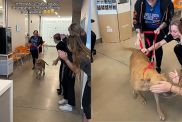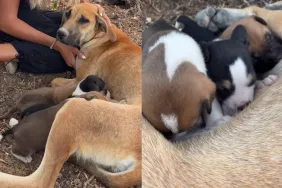Signs of a healthy coat
How do you know if your dog’s coat is in good shape? Just use your senses.
- A healthy coat should feel pliable and smooth, even the wiry pelts of dogs like Terriers. If the texture’s dry or coarse, or if the hair’s brittle and broken (yes, dogs get split ends too), then you need to take action.
- A healthy coat looks good, too. Think about it the same way you think about your own hair: you want your pet’s coat to be shiny and lustrous, bouncy and resilient, not limp or bristly or dull.
- The coat should smell good, even when it hasn’t just been washed. In fact, if her coat’s dry and well cared for, and you’re washing her about once a month or so, your dog shouldn’t smell bad at all. A rancid, oily, or sour odor signals that bacteria are breaking down the skin’s natural protective oils. Your dog may be suffering from flea bites, or hot spots, or very dry skin.
What keeps the coat healthy
The single most important factor in growing a gorgeous coat is good nutrition, or a diet rich in fatty acids and meat, poultry, or fish. This means that the label on the package should list some kind of meat (beef, lamb), poultry (chicken), or fish as the first and most dominant ingredient–not corn, wheat, barley, or rice. For extra shine, some nutritionists also recommend mixing a teaspoonful of vegetable oil into your dog’s food once or twice a day.
Practicing good flea control is also very helpful, so stick to a schedule of applying flea prevention product (suggestions include Frontline, Advantage, or Revolution) every month.
Dietary supplements may or may not help. If you think your dog’s coat isn’t all it should be, try switching foods first. If that doesn’t work, a vet may be able to help you decide whether it makes sense to feed your dog omega-3s, or some other type of essential fatty acids supplement. Feel free to experiment yourself–these healthy fats can only help your dog. But be aware it will be a matter of weeks or months before you’ll be able to notice any significant improvement.
Hot spots
Any dog with matted or dirty hair or a naturally thick coat may be more prone to hot spots–a bacterial infection officially called pyrotraumatic dermatitis, or moist eczema. Hot spots begin as infected bites or scratches, and as the infection spreads–very rapidly–hair falls out, pus forms, and the area begins to smell awful. The spot is actually warm to the touch.
Hot spots are most common in breeds with thick coats, such as Golden Retrievers, Cocker Spaniels, English Springer Spaniels, and German Shepherds, and they occur more often in the warmer months. But they can afflict any dog at any time of the year. You can help stay on top of them by shaving your dog closely during the summer.
Shedding
Shedding isn’t necessarily a sign of a problem. Even if you can pluck out clumps of fur, as long as the coat is reasonably dense with no bald spots, your dog’s hair loss is probably normal.
But the process of growth, rest, shedding, and regrowth is part of the canine coat life cycle, and it’s perfectly normal. Your best strategy for dealing with it is to make sure your vacuum cleaner’s in good working order.
When it’s time to see the vet
If you see any of these symptoms, it’s time to visit the vet:
- A significant change in your dog’s coat or skin
- Evidence of parasites
- Open sores
- Hot spots or signs of infection
Most of these conditions can be treated by using either a topical cream, medication, or dietary supplements.









